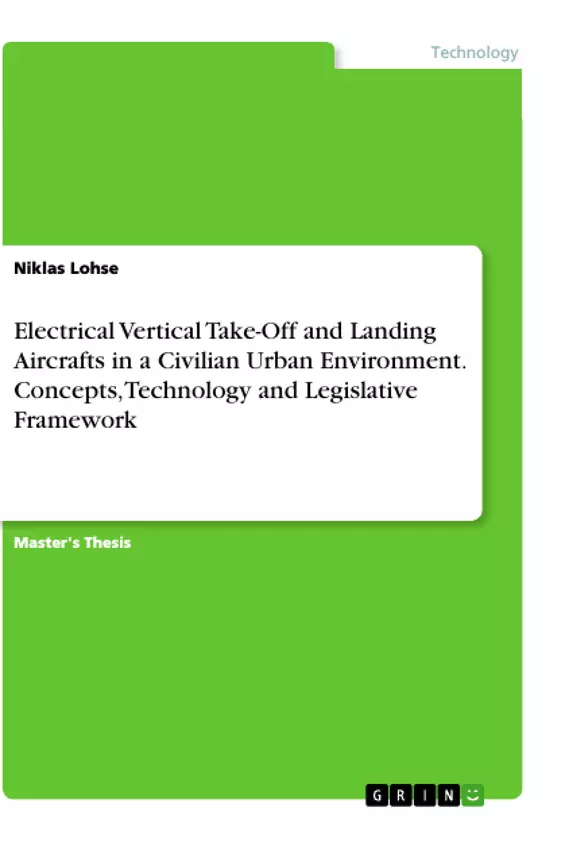This Paper will introduce the most developed concept of vertical take off and landing (VTOL) aircrafts and assess them. It will also analyse the key technology challenges and the legislative situation.
The world’s population is growing and people continue to move from rural to urban areas. This is accompanied by an increasing number of cars. As a result of this, traffic jams in densely populated areas and long commutes are becoming omnipresent. Extension possibilities for existing infrastructure, especially within urban areas, are very limited due to space. Consequently, innovative alternatives are required. Flying cars, also known as vertical take off and landing (VTOL) aircraft, still appear to be a future vision which seems to be far away. However, to date, more than 200 of such concepts around the world are being developed, some of which are even performing flight tests. The objective of this Master’s Thesis therefore is to evaluate if flying cars have a realistic potential to improve the overloaded ground infrastructure systems on a mid-term ten years basis.
In order to answer the research question, a conceptual examination and subsequent classification of the existing concepts is conducted. Based on this a profound content analysis of the four most mature aircraft is carried out. As a result, three significant technical challenges emerge: batteries, noise pollution and the autonomous flying capability. By performing another content analysis on these obstacles, their respective relevance and impact following an upcoming vehicle certification is investigated. Furthermore, VTOL aircraft operations would require legislative amendments. Hence, the current legal situations and actual activities in those regions are studied, where the four companies with the most mature concepts are based.
On that basis it can be concluded, that flying cars have a huge potential to relieve the overstressed infrastructure systems on the ground. Although more than ten years will be required to significantly improve this situation, the first flying cars will most likely be visible much sooner. Technical as well as legal challenges exist, but are not insurmountable and especially the latter are relatively well developed already to enable VTOL operations in an urban environment in the near future.
Inhaltsverzeichnis (Table of Contents)
- Introduction
- Electrical Vertical Take-Off and Landing Concepts
- Vertical Take-Off and Landing Overview
- Methodology to Concept Analysis
- The Lilium Jet
- Technological Concept
- Safety
- Critical Analysis
- Airbus A3 Vahana
- Technological Concept
- Safety
- Critical Analysis
- Aurora Flight Sciences Passenger Air Vehicle
- Technological Concept
- Safety
- Critical Analysis
- Kitty Hawk Cora
- Technological Concept
- Safety
- Critical Analysis
- Comparison of the Different Concepts
- Key Technology Challenges
- Batteries
- Noise Pollution
- Autonomous flying
- Key Legislative Challenges
- Organization of Aviation Law
- Amendments to enable eVTOL Aircraft Operations
- Conclusion
- Outlook
Zielsetzung und Themenschwerpunkte (Objectives and Key Themes)
This Master's Thesis aims to evaluate the potential of flying cars, also known as vertical take-off and landing (VTOL) aircraft, to improve congested ground infrastructure systems in urban areas within a ten-year timeframe. The thesis focuses on assessing the feasibility and potential benefits of eVTOL aircraft in a civilian urban environment.
- Analysis of existing VTOL aircraft concepts and their technical feasibility.
- Identification and evaluation of key technical challenges related to batteries, noise pollution, and autonomous flying.
- Exploration of legislative requirements and potential amendments needed to facilitate eVTOL operations.
- Assessment of the impact of eVTOL technology on urban mobility and infrastructure.
- Evaluation of the potential timeline for the implementation of eVTOL aircraft in a civilian setting.
Zusammenfassung der Kapitel (Chapter Summaries)
The thesis begins with an introduction to the growing problem of urban congestion and the potential of VTOL aircraft as a solution. It then dives into a comprehensive analysis of existing VTOL concepts, outlining their technological features, safety considerations, and critical analyses.
The subsequent chapters delve into key technology challenges, including the limitations of batteries, noise pollution generated by VTOL aircraft, and the development of autonomous flying capabilities. The thesis further explores the legislative frameworks governing aviation and the necessary amendments to enable eVTOL operations in urban areas.
Schlüsselwörter (Keywords)
This Master's Thesis focuses on the integration of electrical Vertical Take-Off and Landing (eVTOL) aircraft into a civilian urban environment. Key keywords and topics include: VTOL concepts, technology analysis, battery technology, noise pollution, autonomous flying, legislative framework, urban air mobility (UAM), and the future of transportation.
- Citar trabajo
- Niklas Lohse (Autor), 2019, Electrical Vertical Take-Off and Landing Aircrafts in a Civilian Urban Environment. Concepts, Technology and Legislative Framework, Múnich, GRIN Verlag, https://www.grin.com/document/508677



